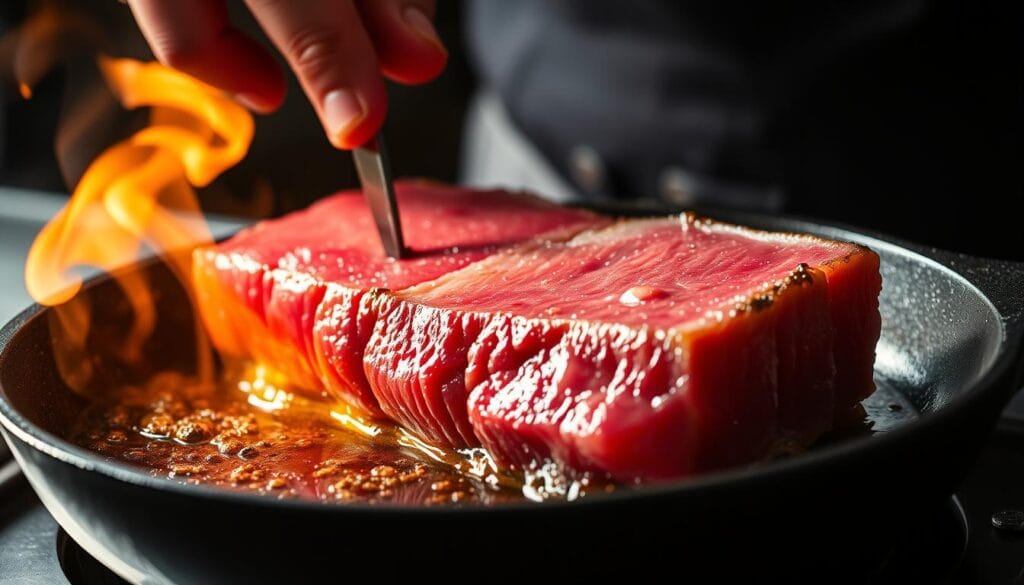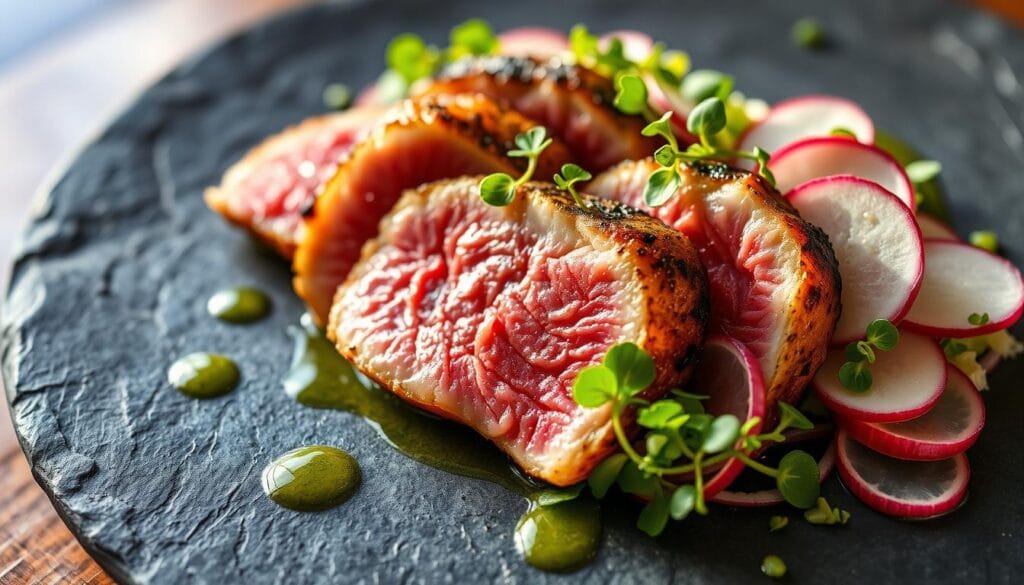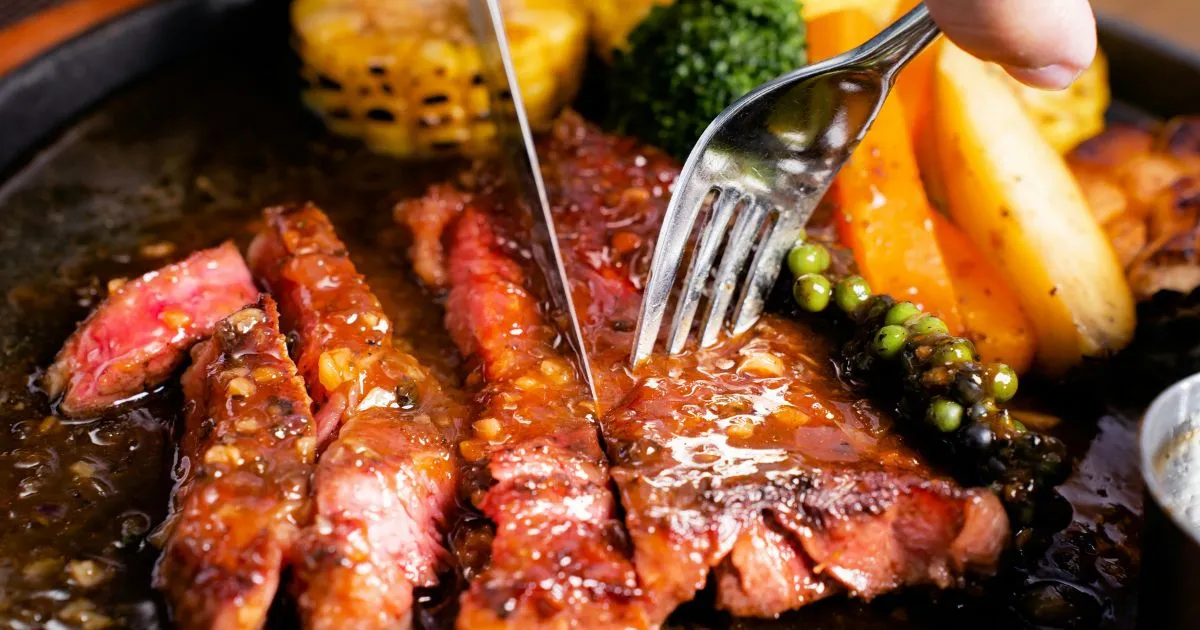
Table of Contents
tuna casserole recipe
Seared ahi tuna is a hit in kitchens everywhere. It’s a fast, fancy meal that’s easy to make. This dish turns simple fish into a fancy restaurant-quality meal with little effort. It’s perfect for seafood lovers and beginners alike, boosting your cooking skills.
Seared ahi tuna is loved for its simplicity and quick cooking time. Chefs and home cooks enjoy the method that gives a crispy outside and a soft, almost raw inside. With the right ingredients and a few cooking tips, you can make a beautiful seafood dish in no time.
Key Takeaways
- Quick and easy gourmet seafood preparation
- Minimal cooking time required
- Versatile dish with multiple seasoning options
- Nutritious protein source with high omega-3 content
- Restaurant-quality meal prepared at home
Understanding Ahi Tuna: A Premium Seafood Choice
Ahi tuna is a top choice in the seafood world. Chefs and home cooks love it for its quality and flexibility. It’s great for seared dishes or tuna tartare.
“Ahi” means yellowfin and bigeye tuna found in Hawaiian waters. These fish have a rich, meaty texture and unique flavor. They’re perfect for many dishes.
Different Grades of Ahi Tuna
Ahi tuna comes in several quality levels:
- Sashimi Grade: The best, great for raw dishes like tuna tartare
- Sushi Grade: High quality for raw or lightly cooked meals
- Standard Grade: Best for fully cooked ahi tuna recipes
Identifying Fresh Ahi Tuna
Choosing the best ahi tuna is important. Look for these signs when picking fish for your seared ahi tuna:
- Bright, deep red color
- Firm, glossy look
- No strong fish smell
- Little to no browning
Health Benefits of Ahi Tuna
“Fresh ahi tuna is not just delicious—it’s a nutritional powerhouse,” says marine nutrition expert Dr. Sarah Roberts.
Ahi tuna is full of good stuff:
- High in lean protein
- Rich in omega-3 fatty acids
- Excellent source of vitamin D
- Low in calories
Whether you love cooking or just want healthy food, ahi tuna is a great choice. It’s tasty, nutritious, and versatile.
Essential Ingredients for Seared Ahi Tuna
Making a great ahi tuna recipe starts with picking the best ingredients. The main ingredient is fresh ahi tuna. It needs careful picking and getting ready.
For a top-notch seared ahi tuna recipe, you’ll need:
- Ahi Tuna: Pick sushi-grade yellowfin or bigeye tuna. It should be deep red and have little marbling.
- High-Heat Cooking Oil: Use avocado or grapeseed oil. They have high smoke points.
- Seasonings: Use kosher salt, black pepper, and maybe some spice blends.
- Optional Marinade: Try soy sauce, sesame oil, or ponzu for extra taste.
For a tuna tartare recipe, you’ll use similar ingredients but with some different steps. The quality of your ahi tuna is key. Choose fresh, sushi-grade cuts from trusted seafood markets.
Experts say to pick tuna steaks that are:
- Vibrant in color
- Firm to the touch
- Free from strong fishy smells
- Evenly shaped for cooking
By using the best ingredients, you’ll make a simple ahi tuna recipe into a dish fit for a restaurant.
Kitchen Tools and Equipment Needed
Preparing the perfect seared ahi tuna needs more than skill—it needs the right tools. Whether you’re making a fish tartare or a seared tuna dish, the right equipment is key to success.
Professional chefs know that quality tools make a big difference. They can turn a simple tuna tartare with avocado into something amazing. Here are the tools you need to make restaurant-quality dishes at home.
Recommended Pans for Searing
Choosing the right pan is essential for a perfect sear on your ahi tuna. Cast iron and stainless steel skillets are best because they distribute heat well and create a great crust.
- Cast iron skillet (12-inch recommended)
- Stainless steel pan with heavy bottom
- Non-stick pan for delicate preparations
Temperature Control Tools
Controlling the temperature is crucial for searing ahi tuna perfectly. These tools help you keep the cooking conditions just right:
| Tool | Purpose | Recommended Brand |
|---|---|---|
| Digital Instant-Read Thermometer | Check internal temperature | Thermapen Mk4 |
| Kitchen Scale | Precise ingredient measurement | OXO Good Grips |
| Infrared Thermometer | Check pan surface temperature | Etekcity Lasergrip |
Additional Kitchen Essentials
Some basic kitchen items are also important for tuna dishes:
- Sharp chef’s knife
- Cutting board
- Tongs
- Paper towels
- Aluminum foil
Pro tip: Always have your mise en place ready before starting to cook your ahi tuna to ensure a smooth cooking process.
Preparing Your Ahi Tuna for Searing
Preparing ahi tuna for searing needs precision and careful handling. Whether you’re making a classic tuna tartare or a perfect seared dish, the prep is key to great results.
Begin by picking high-quality ahi tuna. To make tuna tartare or sear the fish well, follow these steps:
- Check the tuna for even color and firm texture
- Remove any visible skin or connective tissue
- Pat the fish dry with paper towels
- Chill the tuna briefly before cutting for clean slices
Cutting technique is important when preparing ahi tuna. Use a sharp knife for uniform portions, about 1-inch thick. Precision in cutting ensures even cooking and an attractive presentation.
Temperature control is crucial. Take the tuna out of the fridge 15-20 minutes before cooking. This lets it get close to room temperature. It helps get a perfect sear and keeps the fish’s delicate inside just right.
Pro tip: For a classic tuna tartare, dice the ahi into small, uniform cubes. When searing, use larger portions for a beautiful rare center.
Perfect Seasoning Combinations for Ahi Tuna Recipe -Seared
Improving your ahi tuna poke recipe begins with mastering seasoning. The right mix of spices and herbs can turn a simple fish into a work of art. Chefs aim to balance the ahi tuna’s flavor with other ingredients.
Choosing the best seasoning depends on your taste and the dish you’re making. Ahi tuna fans can explore many flavors, each adding something special.
Asian-Inspired Seasonings
Asian flavors are bold and vibrant for ahi tuna. Here are some top picks:
- Sesame and wasabi blend
- Soy-ginger marinade
- Furikake dry seasoning
Mediterranean Flavor Profiles
Mediterranean seasonings offer a lighter, herb-rich taste for ahi tuna:
- Oregano and lemon zest
- Herbs de Provence mix
- Olive oil and thyme rub
Classic Pepper Crusts
Pepper crusts give a strong flavor for those who prefer it:
| Pepper Type | Flavor Profile |
|---|---|
| Black Pepper | Sharp and intense |
| Mixed Peppercorns | Complex and nuanced |
| White Pepper | Mild and subtle |
Pro tip: Always apply seasonings gently to preserve the ahi tuna’s delicate texture and natural flavor.
Step-by-Step Searing Technique

Learning to sear ahi tuna to perfection needs focus and quick cooking skills. The secret to a great dish is finding the right balance of heat and timing.
To prepare your ahi tuna for searing, follow these steps:
- Pat the tuna steak dry with paper towels
- Let the fish come to room temperature before cooking
- Season it well with kosher salt and black pepper
- Use a high-heat cooking surface like a cast-iron skillet
Experts say a cast-iron skillet is the best for a great sear. Matthew McConaughey’s tuna salad recipe also uses these methods for top-notch results at home.
“The secret is to cook it fast and hot, keeping the center rare and tender” – Professional Chef
Getting the sear right means controlling the temperature:
| Cooking Stage | Temperature | Cooking Time |
|---|---|---|
| Pre-heating skillet | High (400-450°F) | 2-3 minutes |
| First side sear | High heat | 60-90 seconds |
| Second side sear | High heat | 60-90 seconds |
Remember: The goal is a crispy exterior with a rare, ruby-red center.
For the best results, use a cooking thermometer. It helps you keep the temperature right and avoid overcooking your ahi tuna.
Temperature Guidelines for Safe Consumption
When making ahi food like tuna tartare or seared ahi tuna, knowing food safety is key. Raw and undercooked seafood needs careful handling to avoid health risks.
Raw or partially cooked fish needs strict temperature and preparation rules. Different ahi tuna dishes have their own safety rules.
Recommended Internal Temperatures
Experts say there are specific temperature guidelines for ahi tuna:
- Rare: 115-120°F internal temperature
- Medium-rare: 125-130°F internal temperature
- Well-done: 145°F internal temperature
Food Safety Considerations
When making tuna tartare or seared ahi, follow these important safety steps:
- Buy fresh, high-quality ahi tuna from trusted sources
- Keep fish cold at 40°F or below before cooking
- Use clean tools and cutting boards
- Eat raw or rare fish right after making it
People with weak immune systems, pregnant women, and young kids should not eat raw seafood. This helps lower health risks.
| Ahi Tuna Preparation | Safe Internal Temperature | Risk Level |
|---|---|---|
| Raw Tuna Tartare | Below 40°F | High Risk |
| Seared Ahi | 125-130°F | Moderate Risk |
| Fully Cooked Tuna | 145°F | Low Risk |
Always put food safety first when making and eating ahi tuna dishes.
Complementary Sauces and Dips
Perfecting your seared ahi tuna means finding the right sauce. Whether you’re making tuna tartare or fish tartare, the right dip can make your dish stand out.
Choosing the best sauce depends on what you like and how you cook. Here are some tasty options that go great with seared ahi tuna:
- Spicy Wasabi Mayo: A creamy, zingy sauce that adds heat and depth
- Soy-Ginger Glaze: A classic Asian-inspired combination with umami richness
- Ponzu Citrus Sauce: A light, tangy option that cuts through the fish’s richness
- Sesame-Lime Vinaigrette: A bright, nutty dressing with tropical notes
If you love fish tartare, try making a fusion sauce. Mix sriracha, lime juice, and Japanese mayo for a unique flavor.
Remember, always taste your sauce before serving. You want to enhance the tuna’s flavor, not hide it.
Serving Suggestions and Plating Tips
To make your seared ahi tuna stand out, think about how you present it. The right plating can turn your dish into a feast for the eyes and taste buds. It’s all about creating a restaurant-quality meal at home.

When you make tuna tartare with avocado, looks matter as much as taste. Chefs know that people judge a dish by how it looks first. So, presentation is key to a great dining experience.
Creative Garnish Options
Choose garnishes that match the tuna’s rich flavor and add texture and color:
- Microgreens for a fresh touch
- Toasted sesame seeds for a crunchy bite
- Thin radish slices for a pop of color
- Pickled ginger for a zesty kick
- Edible flowers for a fancy look
Wine Pairing Recommendations
Finding the perfect wine can take your tuna tartare to the next level. Here are some top picks:
- Crisp Sauvignon Blanc
- Dry Riesling
- Light Pinot Noir
- Sparkling rosé
“The right wine transforms a meal from mere sustenance to a memorable culinary journey.”
With elegant plating and the right wine, you’ll wow your guests. Your meal will be a feast for the eyes and taste buds.
Converting Leftover Ahi into Poke Bowls
Turn your leftover seared ahi tuna into a tasty ahi tuna poke recipe. This way, you can make a fresh and exciting dish easily.
First, gather these key ingredients for your poke bowl:
- Leftover seared ahi tuna, cubed
- Cooked sushi rice
- Sliced cucumber
- Diced avocado
- Chopped green onions
- Sesame seeds
To make your ahi tuna poke recipe, just follow these steps:
- Start with a base of sushi rice in a bowl
- Cut leftover ahi tuna into small cubes
- Place tuna and fresh veggies on top of the rice
- Drizzle with ponzu sauce or soy-based dressing
- Add sesame seeds and green onions on top
Poke recipes ahi are super flexible. You can add things like edamame, pickled radishes, or spicy mayo. This way, you avoid wasting food and make a meal that tastes like it came from a restaurant.
Pro tip: Store leftover ahi tuna in the fridge and use it within 1-2 days. This keeps it fresh and safe to eat.
Troubleshooting Common Searing Issues
Mastering the ahi tuna recipe -seare can be tough for home cooks. Even skilled chefs face challenges when cooking this delicate seafood. Knowing common searing problems helps you make a perfect classic tuna tartare recipe every time.
Uneven searing is a big problem for many. The secret to a beautiful golden-brown exterior is in the pan and temperature.
- Use a heavy-bottomed cast-iron skillet for even heat
- Make sure the pan is very hot before adding tuna
- Pat the tuna dry to remove extra moisture
Managing temperature is key when cooking ahi tuna. Overcooking can turn your fish into a tough, dry meal.
| Tuna Thickness | Recommended Searing Time | Desired Doneness |
|---|---|---|
| 1/2 inch | 30-45 seconds per side | Rare to Medium-Rare |
| 3/4 inch | 45-60 seconds per side | Medium |
| 1 inch | 60-90 seconds per side | Medium-Well |
When searing ahi tuna, watch for these common warning signs:
- Gray or brown coloration indicates overcooking
- Dry, flaky texture suggests too much heat
- Lack of pink center means incorrect cooking time
Professional chefs suggest using high-smoke-point oils like grapeseed or avocado. This helps prevent burning and gets that perfect golden crust on your ahi tuna recipe.
Conclusion
Now you can make a tasty ahi tuna recipe seared to perfection. This guide has given you the skills to turn simple ahi into a top-notch dish. The secret is choosing fresh tuna, mastering searing, and trying new seasonings.
Home cooks can improve their cooking by trying these methods and being creative. You can use Asian flavors or a classic pepper crust. Start with the basics and get better at cooking seafood.
Every time you sear tuna, you learn and get better. Try new flavors, temperatures, and ways to present it. Your homemade seared ahi tuna will wow everyone, making your meals feel like a restaurant experience.
Creating amazing ahi food is just as fun as eating it. Enjoy the process, believe in yourself, and savor the flavors of perfectly seared ahi tuna.
FAQ
What is ahi tuna and how is it different from other types of tuna?
Ahi tuna is a high-quality yellowfin or bigeye tuna found in tropical waters. It’s known for its rich, meaty texture and mild flavor. This makes it perfect for searing, poke bowls, and raw dishes like tartare.
Unlike canned tuna, ahi is sold fresh as steaks. It has a deeper red color and firmer texture.
How do I know if the ahi tuna I’m buying is fresh?
Look for ahi tuna with a deep red or bright pink color. It should be moist but not wet, with a clean ocean smell. The flesh should be firm and bounce back when pressed.
Avoid fish with brown edges, dull color, or a strong fishy smell. Buy from a reputable fishmonger or seafood market to ensure freshness.
What internal temperature is safe for seared ahi tuna?
For seared ahi tuna, the internal temperature depends on your preference. Rare centers should be 115-120°F, while medium-rare is 125-130°F. But remember, raw or undercooked fish can be risky, so use high-quality, sushi-grade tuna.
Can I prepare ahi tuna in advance?
While ahi tuna is best fresh, you can prep some parts ahead. Season the tuna and refrigerate it for up to 24 hours before cooking. You can also make sauces and marinades 2-3 days early.
But sear the tuna just before serving for the best taste and texture.
What are the best seasonings for ahi tuna?
Popular seasonings include sesame seeds, black pepper, sea salt, wasabi powder, and Asian-inspired blends. Mediterranean-style seasonings like herbes de Provence or za’atar also work well. Use light seasonings to enhance the tuna’s flavor without overpowering it.
How long should I sear ahi tuna?
Cook each side of the tuna steak for 1-2 minutes over high heat. This creates a golden-brown crust while keeping the center rare or medium-rare. Total cooking time should be 3-4 minutes to avoid overcooking.
What are some good side dishes to serve with seared ahi tuna?
Great side dishes include Asian slaw, quinoa salad, edamame, roasted vegetables, seaweed salad, and rice pilaf. Choose light, fresh sides that complement the tuna’s flavor. Adding a zesty sauce or citrus-based dressing can enhance the dish.
How can I turn leftover seared ahi tuna into a poke bowl?
Dice the leftover tuna into small cubes and mix with rice, cucumber, avocado, seaweed, and sesame seeds. Use a dressing made from soy sauce, rice vinegar, and sesame oil. Poke bowls are a great way to reuse leftover tuna and create a new meal.



1 thought on “How to Make tuna casserole recipe : Easy Recipe”